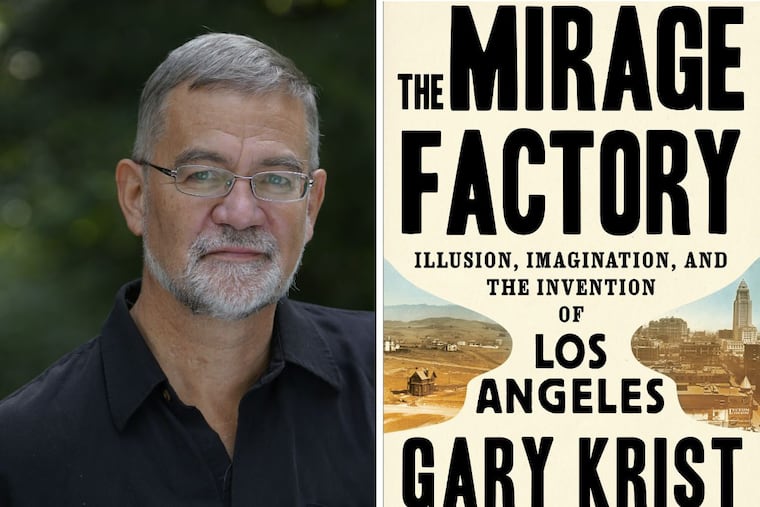Gary Krist's 'Mirage Factory': Three great lives that helped L.A. grow
In "The Mirage Factory," Gary Krist turns his historian's eye to the explosive early history of Los Angeles.

The Mirage Factory
Illusion, Imagination and the Invention of Los Angeles
By Gary Krist
Crown 432 pp. $27
Reviewed by Allen Barra
"Behind every great fortune," wrote Balzac, "there lies a crime." Behind every great city, then, there must be enough crimes to fill a book.
The crimes of Los Angeles, in the hands of Gary Krist, have now filled a fat, juicy volume. Krist, who exposed old Chicago in City of Scoundrels and New Orleans in Empire of Sin, now takes on the creation of the City of Angels, a metropolis that absorbed America's dreams and reflected them back in measures of fantasy, horror, and self-satisfaction.
Krist, also an accomplished writer of fiction (most notably The Garden State) knows how to develop a narrative. The Mirage Factory might be subtitled "A History of L.A. in Three Lives" – those of engineer William Mulholland, filmmaker D.W. Griffith, and evangelist Aimee McPherson.
Mulholland is a strong argument against the notion that individuals don't influence history. Born in 1855 in Belfast, Ireland, to lower-middle-class parents, he ran away from home as a teenager and by age 20 had made his way to America. He was, says Krist, "intrigued with the idea of California's healthy sunshine, open spaces, and unlimited opportunities."
A self-taught engineer and a man of genius, Mulholland came to dominate the city's lifeblood, its water works system. With breathtaking technical ingenuity and appalling political strong-arming, he took water from Owens Valley and other sources and brought it as far as 250 miles to L.A, essentially inventing the city. "When the city bought the works," he famously said, "they bought me with it."
David Wark Griffith, born in 1875 in Kentucky, was a small-time silent movie actor, but what he really wanted to do was direct. He was one of the first men to see the possibility of developing "flickers" into an industry more influential than the staged play or novel, and, incredibly, one of the first to perceive that L.A.'s climate might be more suitable than New Jersey's for making movies. His vision was bigger than the money men could ever have imagined. Watching an early Griffith film and trying to wrap his head around the skillful editing and parallel story lines, an exasperated executive said, "How can you tell a story jumping about like that? The people won't know what it's about."
Enough people knew what Intolerance (1915) and The Birth of a Nation (1916) were about to establish movies as an art form, popular entertainment, and big business. By then, "D.W.," as he became known, was, in the words of fellow filmmaker Henry King, "the master that every young director watched, studied, and imitated."
The most unlikely of Krist's three central players was McPherson, born in a farmhouse in rural Ontario in 1890. At 17, she chanced on a Pentecostal meeting and underwent a revelation that rivaled St. Paul's. Within a few years she'd developed a flamboyant preaching style that captivated audiences, creating thousands of converts.
One historian thought that L.A. had always been "a breeding place and a rendezvous of freak religions." But there was nothing freak about Aimee's preaching. If anything, it contained a strong strain of California-style attitude. "I think the less we hear about Hell," she told her congregations, "the better. Don't you? Let's forget about Hell!"
With McPherson, religion went Hollywood. In the early 1920s, as broadcast radio became popular, Sister McPherson "recognized it as an opportunity to spread the word even more efficiently." She preached the gospel through radio shows such as The Sunshine Hour.
On one occasion, she wore a University of Southern California football uniform and sermonized about "carrying the ball for Christ." On another, she wore a patrolman's uniform and posed for a picture next to a police motorcycle to "put sin under arrest." Drawing large crowds to her services, which often featured faith healing, she would count the house with one eye, then, before the offering, tell her flock, "Sister has a headache tonight" so "just quiet money please" (that is, no change). Charlie Chaplin phrased it best when he told her, "Whether you like it or not, you're an actress."
In the end, Krist says, "Mulholland, Griffith, and McPherson all paid a price for their ambitions. Each self-destructed in the late 1920s in spectacular fashion … But while these individuals fell, the city they had worked to build barely registered their loss, entering the 1930s as the largest and fastest-growing U.S. city west of the Mississippi."
If I were the mayor of a major American city and I heard Gary Krist was headed my way, I'd have the highways, railways, and airports on alert to keep him out. Too late, though, for L.A. The Mirage Factory is essential reading for the understanding and enjoyment of America's dream factory.
Allen Barra writes about books for the Daily Beast, Truthdig.com, and the Guardian.